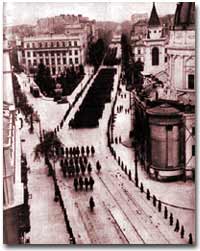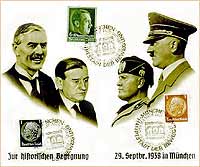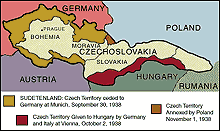50c. War Breaks Out

German troops parade through Warsaw in September 1939 following their invasion of Poland. Britain and France responded to this action with declarations of war against Germany. World War II was officially underway.
On July 7, 1937, a skirmish between Chinese and Japanese troops broke out at the Marco Polo Bridge near Beijing. The cause of the fracas is unknown, but the Japanese government used it as a pretext to launch a full-scale invasion of China. Hoping to deliver a quick knockout punch, the Japanese furiously bombed Chinese cities and advanced with their better-equipped army. Despite enduring heavy losses, the Chinese regrouped in the interior of their vast land and mounted an entrenched resistance.
Reports of the "rape of Nanking," the sacking of the Chinese capital reached the American mainland in the summer of 1937. The brutalities prompted President Roosevelt to abandon cooperation with Congressional isolationists to pursue a more forceful approach against the Japanese.

The Munich Pact of 1938 recognized Germany's claim to the Sudetenland and Italy's claim to Ethiopia in exchange for the promise of no further aggressions. This memorial sheet depicts Neville Chamberlain and Eduardo Daladier, the leaders of Britain and France, standing opposite Adolf Hitler and Benito Mussolini.
In October 1937, he delivered his famous Quarantine Speech in Chicago. For the first time, Roosevelt advocated collective action to stop the epidemic aggression. But his hopes of igniting American sensibilities failed. Even when a Japanese plane bombed the USS Panay on December 12, there was no cry for a response. The Panay had been stationed in China on the Yangtze River. Japan apologized and paid an indemnity and the incident was soon forgotten, despite the loss of three American lives. Compared to the public response to the sinking of the Maine in 1898, the American people hardly mustered a whisper.
Emboldened by western inaction, Hitler's troops marched into Austria in 1938 and annexed the country. Then Hitler set his eyes upon the Sudetenland, a region in western Czechoslovakia inhabited by 3.5 million Germans. In September the leaders of Britain, France, Germany, and Italy met in Munich attempting to diffuse a precarious situation.
Britain and France recognized Hitler's claim to the Sudetenland and Mussolini's conquest of Ethiopia in exchange for the promise of no future aggressions. Prime Minister Neville Chamberlain returned to Great Britain triumphantly proclaiming that he had achieved "peace in our time." It would be one of the most mocked statements of the 20th century.

This map of Czechoslovakia shows the fierce land-grabbing that took place in the Fall of 1938. Hungary, Germany, and Poland all managed to claim a piece as their own.
European appeasement failed six months later, as Hitler mockingly marched his troops into the rest of Czechoslovakia.
In May 1939, Roosevelt urged Congressional leaders to repeal the arms embargo of the earlier Neutrality Acts. Senators from both parties refused the request. Another bombshell crossed the Atlantic on August 24. Adolf Hitler and Josef Stalin agreed to put their mutual hatred aside. Germany and the Soviet Union signed a ten-year nonaggression pact. Hitler was now free to seize the territory Germany had lost to Poland as a result of the Treaty of Versailles. On September 1, 1939, Nazi troops crossed into Poland from the west.
Finally, on September 3, France and Great Britain declared war on Germany. World War II had begun.






